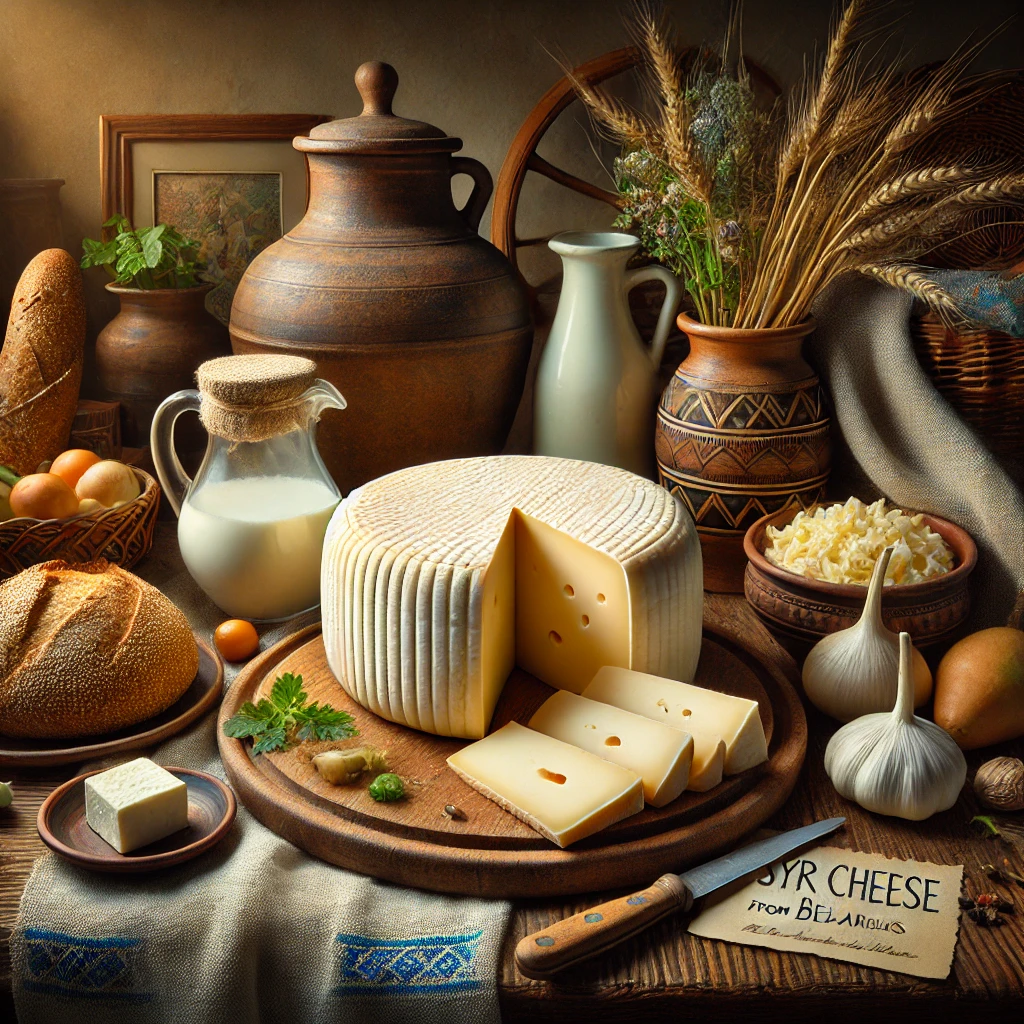Belarus, a country celebrated for its fertile farmlands, hearty dishes, and deep-rooted agricultural traditions, has a long history of dairy craftsmanship. Among its many dairy specialties, Syr (сыр)—also known as Belarusian fresh cheese or tvorog-style cheese—stands out as one of the most cherished. Mild, versatile, and nutrient-rich, Syr is a true staple of Belarusian cuisine, loved across generations.
Although not as globally recognized as feta, mozzarella, or cheddar, Syr remains a central part of rural life in Belarus. Its simplicity, affordability, and natural richness make it a “comfort cheese” in households throughout the region. Today, it continues to play an important role in Belarusian culinary culture, bridging old traditions with modern tastes.
This guide explores everything you need to know about Syr cheese—its origins, how it’s made, flavor, texture, uses, nutritional value, and why it holds such a special place in Belarusian food heritage.
What Is Syr Cheese?
In Belarus, “syr” simply means cheese, but in everyday speech it commonly refers to a specific type of fresh, soft cheese similar to farmer cheese, quark, or cottage cheese. Unlike aged cheeses, Syr is:
-
Soft and moist
-
Mildly tangy
-
Light and crumbly
-
High in protein
-
Made from cow’s milk (traditionally raw or minimally processed)
This cheese is central to Belarusian home cooking, especially in rural areas where families often produce it themselves using milk from their own cows.
Origins: The History of Syr in Belarus
Syr has been part of the Belarusian diet for centuries. Historically, Belarusian farmers relied heavily on dairy for survival. Cows were among the most valuable animals, providing:
-
Milk
-
Butter
-
Cream
-
Fresh cheese (Syr)
Before modern refrigeration, fresh cheese had to be made quickly and consumed within a short time, making it:
-
A daily food
-
A sustainable method of using excess milk
-
A nutritious source of protein
Over time, Syr became the foundation for numerous traditional dishes, pastries, and desserts that remain beloved today.
How Syr Cheese Is Made
Although variations exist, the traditional Belarusian method is simple and requires few ingredients.
1. Fresh Milk Collection
Cow’s milk is preferred—either raw or gently pasteurized.
2. Natural Fermentation
The milk is left at room temperature to sour naturally. Lactic acid bacteria transform lactose into lactic acid.
3. Gentle Heating
Once the milk has thickened, it is warmed slowly until curds separate from whey.
4. Straining
Curds are poured into a cloth or fine strainer to drain excess liquid.
5. Pressing
Depending on the desired firmness, the curds may be lightly pressed.
6. Optional Additions
Salt or herbs may be added, but many Belarusians prefer it plain.
This simple process results in a creamy, mildly tangy cheese ready to be eaten fresh.
Taste Profile: What Does Syr Taste Like?
Syr is known for its clean, fresh, and delicate flavor.
Flavor Notes
-
Mildly sour
-
Fresh and milky
-
Slightly sweet when made from high-fat milk
-
Subtle tang from natural fermentation
Texture
-
Soft and crumbly
-
Moist, but not mushy
-
Creamy when mixed with sugar or cream
Its gentle taste makes it suitable for both sweet and savory dishes.
Varieties of Syr Cheese in Belarus
Though the base cheese remains similar, several forms exist:
1. Fresh Syr (Свежы сыр)
-
Mild
-
Soft
-
Lightly pressed
-
Used for cooking and daily meals
2. Dry Syr
-
Pressed longer
-
Firmer and more crumbly
-
Ideal for baking or frying
3. Sweetened Syr
Made by adding sugar, vanilla, or raisins—popular in desserts.
4. Salted Syr
Enhanced with salt or herbs for savory dishes.
5. Smoked Syr (rare but artisanal)
Some rural producers lightly smoke Syr, giving it a unique aroma.
How Syr Is Used in Belarusian Cuisine
Syr forms the basis of many traditional Belarusian dishes. Here are some beloved ways it is enjoyed:
1. Syrniki (Cheese Pancakes)
Perhaps the most famous use of Syr, syrniki are golden, pan-fried pancakes made from:
-
Fresh Syr
-
Eggs
-
Sugar
-
Flour
They are served with sour cream, honey, or berry jam.
2. Baked Casseroles (Запеканка)
Syr is mixed with:
-
Eggs
-
Semolina or flour
-
Sugar
-
Raisins
Then baked until lightly browned and tender.
3. Savory Dumplings (Варэнікі з сырам)
Dough pockets filled with Syr and sometimes herbs make a comforting meal.
4. Breakfast Spread
Simply served with:
-
Bread
-
Honey
-
Fresh fruit
-
Sour cream
This simple dish offers a nutritious start to the day.
5. Stuffed Pastries
Syr is commonly used as a filling in:
-
Buns
-
Crepes
-
Pirozhki
6. Salads
Dry Syr can be crumbled into vegetable salads for extra protein.
7. Frying
Press-dried Syr can be lightly fried until golden—crispy outside, soft inside.
Nutritional Benefits of Syr Cheese
Syr is considered one of the healthiest dairy products in Belarus.
Rich in Protein
Supports muscle development and satiety.
High in Calcium
Strengthens bones and teeth.
Low in Fat (unless made with whole milk)
Popular in weight-control diets.
Probiotics
Naturally fermented Syr aids digestion and gut health.
Low Lactose (in strained versions)
Easier to digest than fresh milk.
Syr Cheese vs. Cottage Cheese vs. Quark
While similar, there are differences:
| Feature | Syr | Cottage Cheese | Quark |
|---|---|---|---|
| Origin | Belarus & Slavic region | Global | Central Europe |
| Texture | Soft, crumbly | Wet, curdy | Smooth, creamy |
| Flavor | Sour-mild | Neutral | Mild-sour |
| Fat Content | Variable | Often low | Medium |
Syr lies somewhere between cottage cheese and quark, most similar to Eastern European tvorog.
Storage and Shelf Life
Fresh Syr should be consumed quickly.
Storage Tips
-
Refrigerate immediately
-
Consume within 2–4 days
-
For longer storage, press into a firmer shape
-
Avoid freezing (changes texture)
If kept in an airtight container, it retains freshness and flavor.
Modern Popularity: Syr in Contemporary Belarusian Cuisine
Today, Syr is embraced by:
-
Home cooks
-
Local cafés
-
Health-focused consumers
-
Bakeries
-
Culinary students
It fits perfectly into modern food trends like:
-
Low-carb diets
-
High-protein meals
-
Farm-to-table cooking
-
Homemade alternatives to processed foods
Chefs incorporate Syr into fusion dishes, pairing it with global flavors such as:
-
Avocado
-
Smoked salmon
-
Fresh herbs and olive oil
-
Seeds and whole grains
Syr Cheese and Belarusian Culture
More than a food, Syr represents:
-
Rural life
-
Family traditions
-
Self-sufficiency
-
Hospitality
-
Slow, natural food preparation
In many households, making Syr is a weekly ritual passed down from mothers and grandmothers.
Why Syr Cheese Is a Belarusian Culinary Treasure
-
Easy to make
-
Affordable
-
Nutritious
-
Versatile
-
Deeply traditional
-
Loved by all generations
Its simplicity and authenticity are what make it special.
Conclusion: A Timeless Dairy Delight
Syr cheese from Belarus remains one of the country’s most beloved dairy traditions. With its fresh, mild flavor, high nutritional value, and incredible versatility, Syr continues to enrich both everyday meals and festive dishes. As Belarus embraces modern culinary influences, this traditional cheese stands strong as a symbol of comfort, heritage, and nourishment.
Whether enjoyed in syrniki, eaten plain with honey, or baked into a casserole, Syr offers a delicious taste of Belarusian culture—one that deserves global appreciation.



